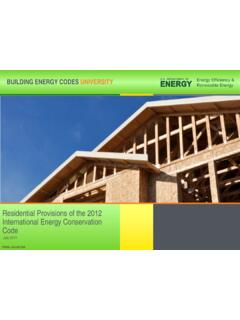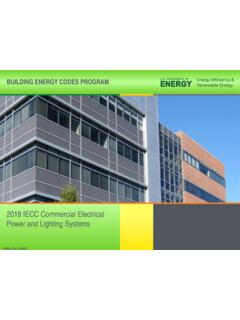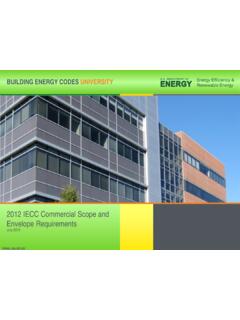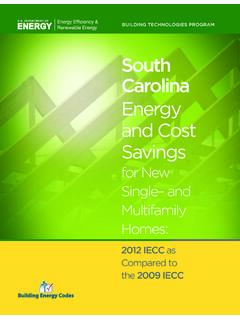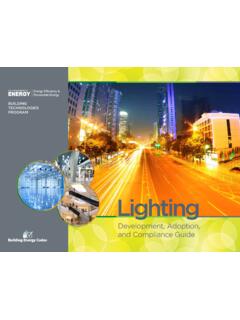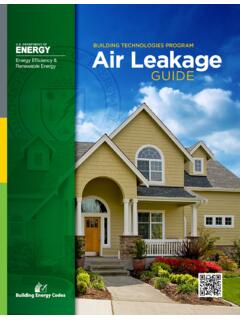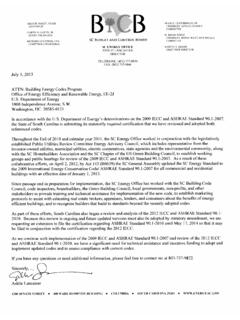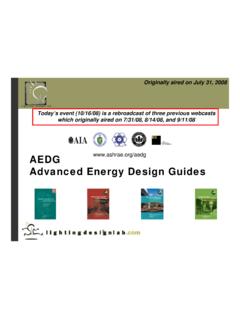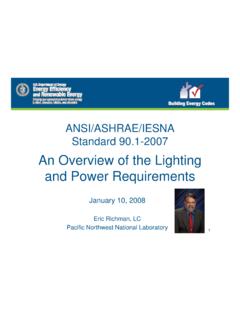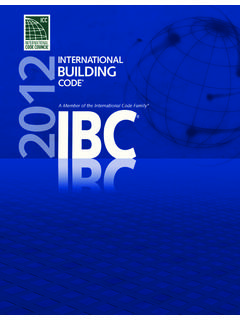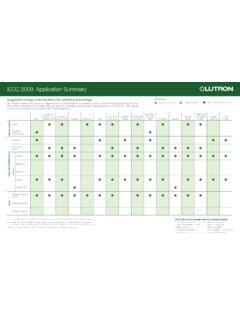Transcription of CODE NOTES - Energy Codes
1 Vestibule Requirements in Commercial BuildingsVestibule Requirements in Commercial BuildingsThe intent of the vestibule requirement is to reduce infiltration of air into a space, thereby addressing Energy conservation and comfort issues for occupants located near primary entrance doors. The majority of infiltration comes through primary entrance doors that are typically used to access public areas, and have higher usage rates than doors classified for personnel use. Vestibules can reduce the infiltration losses (or gains) from wind and stack effects by creating an air lock building designers are required to install vestibules on primary entrance doors leading to and from spaces greater than or equal to 3,000 square feet (298 m2), with some exceptions.
2 Many designers are unclear on what is included in determining the 3,000 ft2 that defines a space. For example, if an entrance door leading from a lobby is attached to a corridor with a combined total area of 3,000 ft2, must the door meet the vestibule requirement? Similarly, which doors must have vestibules when several doors leave a space greater than or equal to 3,000 ft2?The 2009 and 2012 IECC require that primary entrance doors accessing spaces 3,000 ft2 or greater have vestibules. This requirement typically applies to large box stores where the building entrance opens directly to a resale area, or to other occupancies with large lobbies ( , hotels).
3 For office buildings with a lobbies connected to corridors with a combined total area of 3,000 ft2, only those areas that cannot be closed off from the entrance door are included when determining if a vestibule is required. (See Figure 1).ASHRAE and 2010 also require vestibules for entrance doors accessing spaces 3,000 ft2 or greater but with some added requirements not present in the IECC. The first requirement is associated with vestibule envelope requirements. ASHRAE requires that the exterior envelope of a conditioned vestibule comply with the requirements 2009 and 2012 IECC; ASHRAE and 2010 BUILDING TECHNOLOGIES PROGRAMCODE NOTESO cesO ces500 Ft2 Floor Area2600 Ft2 Floor AreaFigure 1.
4 For a conditioned space while the interior and exterior of an unconditioned vestibule must comply with the envelope requirements for a semiheated space. ASHRAE also requires a minimum distance of 7 ft between closed interior and exterior vestibule doors. ASHRAE also contains exceptions for vestibules in Climate Zones 3-8 that do not appear in the IECC. Plan Review1. Verify that doors separating conditioned spaces from the exterior that do not have vestibules are exempt from the Verify that for spaces larger than 3000 ft2 doors separating conditioned space from the exterior contain a vestibule, unless an exception Verify that the doors leading into and out of the vestibule are designed so that, in passing through the vestibule.
5 It is not necessary for the interior and exterior doors to be open at the same Verify that the building assemblies between the conditioned space and the vestibule meet the envelope requirements of the applicable Verify that the vestibule has been constructed according to the approved building plans and Verify that the doors leading into and out of the vestibule are equipped with self-closing Verify that it is not necessary for the interior and exterior doors of the vestibule to be open at the same Citations*IECC 2009, Section VestibulesA door that separates conditioned space from the exterior shall be protected with an enclosed vestibule, with all doors opening into and out of the vestibule equipped with self-closing devices.
6 Vestibules shall be designed so that in passing through the vestibule it is not necessary for the interior and exterior doors to open at the same : 1. Buildings in Climate Zones 1 and 2, as indicated in Figure and Table Doors not intended to be used as a building entrance door, such as doors to mechanical or electrical equipment Requirements in Commercial Buildings (Continued)2009 and 2012 IECC; ASHRAE and 2010 code NOTES3. Doors opening directly from a sleeping unit or dwelling Doors that open directly from a space less than 3,000 ft2 in Revolving Doors used primarily to facilitate vehicular movement or material handling and adjacent personnel 2012, Section VestibulesAll building entrances shall be protected with an enclosed vestibule, with all doors opening into and out of the vestibule equipped with self-closing devices.
7 Vestibules shall be designed so that in passing through the vestibule it is not necessary for the interior and exterior doors to open at the same time. The installation of one or more revolving doors in the building entrance shall not eliminate the requirement that a vestibule be provided on any doors adjacent to revolving : 1. Buildings in Climate Zones 1 and Doors not intended to be used by the public, such as doors to mechanical or electrical equipment rooms, or intended solely for employee Doors opening directly from a sleeping unit or dwelling Doors that open directly from a space less than 3,000 ft2 (298 m2) in Revolving Doors used primarily to facilitate vehicular movement or material handling and adjacent personnel NOTESV estibule Requirements in Commercial Buildings (Continued)2009 and 2012 IECC.
8 ASHRAE and 2010 ASHRAE , Section VestibulesBuilding entrances that separate conditioned space from the exterior shall be protected with an enclosed vestibule, with all doors opening into and out of the vestibule equipped with self-closing devices. Vestibules shall be designed so that in passing through the vestibule it is not necessary for the interior and exterior doors to be open at the same time. Interior and exterior doors shall have a minimum distance between them of not less than 7 ft when in the closed position. The exterior envelope of conditioned vestibules shall comply with the requirements for a conditioned space.
9 The interior and exterior envelope of unconditioned vestibules shall comply with the requirements for a semiheated :a. Building entrances with revolving Doors not intended to be used as a building Doors opening directly from a dwelling Building entrances in buildings located in Climate Zone 1 or Building entrances in buildings located in Climate Zone 3 or 4 that are less than four stories above grade and less than 10,000 ft2 in Building entrances in buildings located in Climate Zone 5, 6, 7, or 8 that are less than 1,000 ft2 in Doors that open directly from a space that is less than 3.
10 000 ft2 in area and is separate from the building NOTESEERE Information Center1-877-EERE-INFO (1-877-337-3463) May 2012*Copyright, 2010, American Society of Heating, Refrigerating, and Air Conditioning Engineers, Atlanta, GA. ASHRAE Standard Reproduced with permission. All rights reserved.*Copyright 2011, International code Council, Inc. Falls Church, Virginia. Reproduced with permission. All rights reserved. 2012 International Energy Conservation code .*Copyright 2011, International code Council, Inc. Falls Church, Virginia. Reproduced with permission. All rights reserved.
